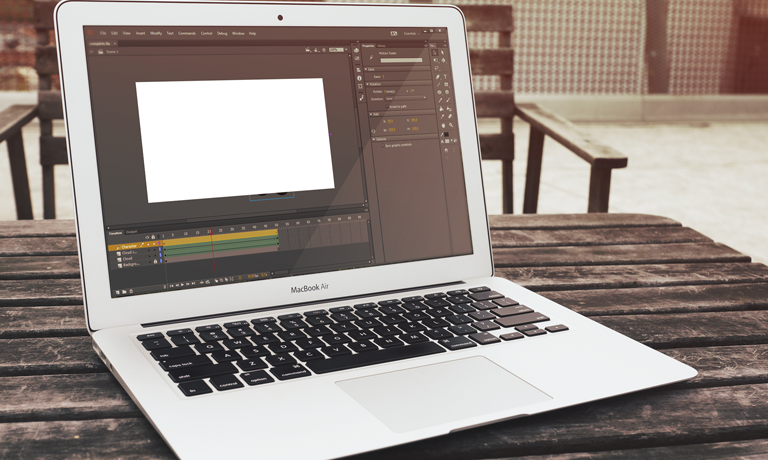Instructors
Adobe Flash CC 2014: Part 1
Course Specifications
Course Number:
092043
Course Length:
1 day
Course Description
Overview:
The tools available in Adobe® Flash® CC can be used to create and manipulate a variety of graphics and animations ranging from simple designs to complex animated sequences. In this course, you will learn to navigate the Flash CC interface and gain knowledge in using the tools and features necessary for drawing graphics and creating a website that contains an animated introduction.
You can also use this course to help prepare for the Rich Media Communication with Adobe Flash exam.
This course covers the Interactive Media Using Adobe Flash Professional CC objectives to help students prepare for the Adobe Certified Associate (ACA) exam. This course is also designed to cover the Adobe Certified Expert (ACE) exam objectives.
Course Objectives:
In this course, you will be introduced to the Adobe Flash CC application and interface and develop an animated website.
You will:
- Get started with Flash CC.
- Plan a Flash project.
- Create illustrations in Flash.
- Organize a Flash project.
- Import assets into Flash.
- Create animation.
- Add basic ActionScript to a Flash project.
Target Student:
The target student for this course is a designer or developer who is new to Flash. The student may be a graphic designer, website developer, multimedia designer, or game designer. This course, combined with the Logical Operations Adobe® Flash® CC: Part 2 course, covers the Adobe Rich Media Communication using Adobe Flash CC objectives, and is intended to help prepare students to take the Adobe Certified Associate exam.
Prerequisites:
To ensure your success in this course, you should be familiar with the Windows® environment, have a strong sense of the web and its terminologies, have a basic frame of reference for graphic and design applications, and have a desire to know the basic terminologies and components of ActionScript® and its role as a Flash programming language. You can obtain this level of skill and knowledge by taking the following Logical Operations course: Introduction to Personal Computers Using Windows® 8.
Course-specific Technical Requirements
Hardware
For this course, you will need one computer for each student and one for the instructor. Each computer will need the following minimum hardware configurations:
- Intel® Pentium® 4, Intel® Centrino®, Intel® Xeon®, or Intel® Core™ Duo (or compatible) processor
- 4 gigabyte (GB) RAM
- 2.5 GB of available hard-disk space for installation; additional free space required during installation (cannot install on removable flash storage devices)
- 1024 x 768 resolution monitor (1,280 × 800 recommended)
- Internet connection and registration necessary for required software activation, membership validation, and access to online services
- Keyboard and mouse (or other pointing device)
- Projection system to display the instructor’s computer screen
Software
- Microsoft® Windows® 7 or 8/8.1 (32-bit or 64-bit)
- Adobe Flash Professional CC
- Microsoft® Word 2010 and up
- QuickTime® 10x recommended
- Any PDF reader
- If necessary, software for viewing the course slides (instructor machine only)
This course was created and keychecked using Windows 8.
Course Content
Lesson 1: Getting Started with Flash CC
Topic A: Identify Components of the Flash CC Interface
Topic B: Identify Elements of a Flash Project
Topic C: Customize the Flash CC Interface
Lesson 2: Planning a Flash Project
Topic A: Establish Project Requirements and Documentation
Topic B: Implement Best Practices in Rich Media Design
Lesson 3: Creating Illustrations in Flash
Topic A: Start a New Project
Topic B: Draw Basic Shapes
Topic C: Draw Advanced Shapes
Topic D: Add Static Text
Lesson 4: Organizing the Project
Topic A: Organize the Library
Topic B: Create Visual Depth Using Layers
Topic C: Use Symbols to Organize for Reuse
Lesson 5: Importing Assets into Flash
Topic A: Import Copyrighted Material
Topic B: Import Bitmap and Vector Images
Topic C: Optimize Bitmap Images for Flash
Lesson 6: Creating Animation
Topic A: Create Frame-by-Frame Animation
Topic B: Create Tweens and Embedded Animation
Topic C: Create Motion Tween Animations
Topic D: Animate a Mask
Topic E: Create a Button Rollover
Topic F: Work with Motion Paths
Lesson 7: Adding Basic ActionScript
Topic A: Apply ActionScript to Control Animation
Topic B: Add Button Actions
Appendix A: Adobe Flash CC Tools
Appendix B: Interactive Media Using Adobe Flash Professional CC Certification Exam Objectives
Appendix C: Adobe Certified Expert Flash CC Exam Mapping
Course Reviews
No Reviews found for this course.


